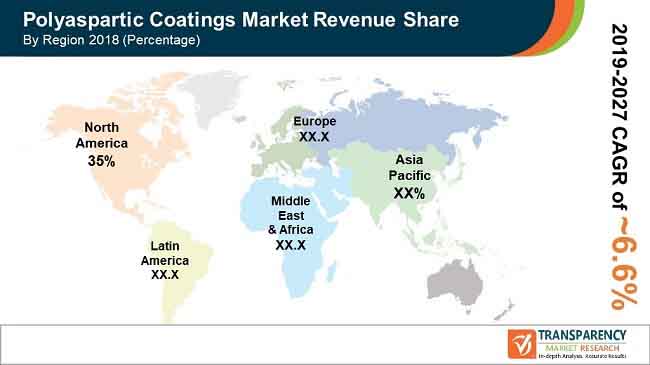
Global Polyaspartic Coatings Market: Key Highlights
- The global demand for polyaspartic Coatings stood nearly US$ 525 Mn in 2018 and is projected to reach over US$ 931 Mn by 2027. Increased awareness and a recovering construction industry are some of the factors improving the market scenario of polyaspartics globally. Thus, the polyaspartic coatings market expected to exhibit the highest growth rates over other coatings in the coatings market.
- Polyaspartic coatings are a comparatively new product type of in the paints & coating market, and is gaining momentum across world. The coating is usually occur as a 2-part system, and is derived by mixing resin with a catalyst in order to initiate a curing reaction that leads to hardening of the materials. This imparts high durability and hardness to the polyaspartic coating resins. Reduced drying times, greater film thickness, odourless, low colour values, long pot life and high compatibility with most surfaces makes these coatings superior to their counterparts such as epoxy, polyurethane etc.
- Easy availability of substitutes such as epoxy, polyurethane etc., volatility in raw material prices and low product awareness among consumer are some of the factors restraining the market.
- Rising research activities in field of high performance environmental friendly protective coatings for marine, automotive, and power generation industry expected to boost the water based polyaspartic coatings market.

To gauge the scope of customization in our reports Ask for a Sample
Global Polyaspartic Coatings Market: Segmental Insights
- Demand for water based segment expected to increase significantly over the forecast period due to its characteristic features such as low VOC and high durability. Demand for solvent based technology expected to decline during the forecast period due to rising stringent regulations on VOC emissions and rising interest for LEED certified buildings.
- Powder based technology is the least attractive segment in the market due to high production cost, inability to product thin finish, and risk of contamination.
- In terms of revenue, construction held a major share of more than 50% in global polyaspartic coatings market in 2018. Increasing demand for green and sustainable building products that consumes less energy and emits less CO2 and VOC estimated to drive the polyaspartic coatings market. Polyaspartic coatings provides better UV stability and high durability compared to its counterparts. Thus, increasing need for cost-effective protective, waterproofing coating products in the market due to the unpredictable weather, rising cost of living, and changing lifestyles pushing manufacturers to produce technologically advanced products in the market which is propelling the global polyaspartic coatings market.
Get an idea about the offerings of our report from Report Brochure
Global Polyaspartic Coatings Market: Regional Insights
- In 2018, North America was the leading consumer of polyaspartic coatings market followed by Asia Pacific. Stringent building regulations and a focus on reducing VOC emission have been major factors for the high adoption rate of polyaspartic coatings in North America. There is a higher emphasis on green building, energy saving, and superior waterproofing products due to the varying climatic conditions in the region.
- Demand for polyaspartic coatings in Asia Pacific originates from new construction projects and refurbishment of existing buildings. Development programs regarding quality products and foreign direct investment (FDI) are boosting the housing and commercial sectors.
- Europe combined with Asia Pacific held more than 50% share of the total consumption of polyaspartic coatings. Expansion of the automotive sector in China, India, Indonesia, Malaysia, Thailand, and Vietnam is estimated to propel the demand for polyaspartic coatings during the forecast period. Increasing the content of plastics in vehicles requires low-temperature cure coating systems. The automotive industry is rapidly moving toward an 80°C cure process and faster drying, with very high gloss. In addition, rise in demand for automotive refinish performance characteristics such as self-healing and self-cleaning or resistance/easy removal of dirt and solar-reflective functionalities are boosting the demand for polyaspartic coatings in the automotive industry.
- The wind energy market is expanding in Europe due to increase in compliance to substitute fossil and nuclear primary energy with energy generated from renewable sources. Most of the installed wind turbine capacity in Europe are offshore based which require coatings that can withstand intense stress such as impact of heavy rain or hailstorm. Rise in demand for developing large number of offshore wind turbines with higher energy output and improved coatings is driving the polyaspartic coatings market in the region.
Looking for Regional Analysis or Competitive Landscape in Polyaspartic Coatings Market, ask for a customized report
Global Polyaspartic Coatings Market: Competition Landscape
- Major players in the polyaspartic coatings market
- Akzo Nobel N.V
- The Sherwin Williams Company
- PPG Industries
- Covestro AG
- Sika Corporation
- Cipy Polyurethanes Pvt. Ltd
- Rust-Oleum Corporation.
- Government enforcement on improving the durability of concrete structures is pushing manufacturers to develop environment-friendly quality products.
- In March 2024, Akzo Nobel N.V. completed the acquisition of the remaining 25% stake in Akzo Nobel Boya Sanayi ve Ticaret A.S., a major producer of powder coatings in Turkey. The company has now acquired full ownership, having previously held the majority share.
- In January 2024, BASF SE introduced innovative waterproofing membrane, MasterSeal® 730 UVS in Asia, to expand its versatile waterproofing portfolio under its Master Builders Solutions brand.
- In December 2019, BASF SE launched the next generation of high-performance flooring systems, MasterTop XTC, for the construction industry.
- In November 2019, Akzo Nobel N.V. has completed the acquisition of French aerospace coatings manufacturer Mapaero. The deal will strengthen AkzoNobel’s global position in aerospace coatings, notably in the structural and cabin coating sub-segments.
- In October 2019, Coatings for Industry, Inc., (CFI) introduced WearCOAT 2015, a low-VOC polyaspartic primer that offers quick cure times and can be applied at low temperatures. This product is well suited for bakeries, hospitals, restaurants, pharmaceutical and other healthcare facilities, or food service facilities that require both safety and fast return-to-service.
Request for covid19 Impact Analysis – https://www.transparencymarketresearch.com/sample/sample.php?flag=covid19&rep_id=24056





